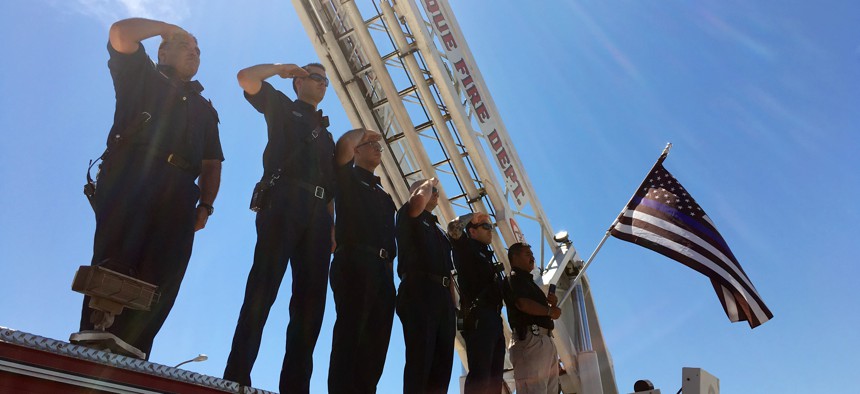
Albuquerque law enforcement officers escort the body of a New Mexico police officer who was shot and killed during a traffic stop as the procession leaves Albuquerque, N.M., Monday, Aug. 15, 2016. Russell Contreras/AP
Keeping America's Principles In the Age of Terrorism
Our security should be judged not only by the absence of major attacks but by America’s commitment to the Constitution.
On September 11, 2001, I was working at my desk in the Pentagon when American Airlines Flight 77 slammed into the opposite side of the building. My eldest child was less than a quarter mile away, settling in for a day of play at the Pentagon Child Care Center. We were both physically unharmed in the attack, and I returned to work on September 12 with other DoD employees to demonstrate that Americans would not bend to terrorism. But of course the events of that day had long-lasting effects for me and all Americans, as well as for the world.
One of the principal effects of 9/11 was instilling in Americans a fear that their personal security was at greater risk than ever before. Many aspects of the post-9/11 world are indeed new, but the fear it evokes echoes that felt by prior generations. At times the country has met those fears while still holding fast to its core democratic principles. Other times, fear has overruled American principles, especially the protection of individual freedoms. The most important legacy of the American experience following 9/11 will not be the novelty of fear, but rather how well the country copes with that fear while adhering to its constitutional framework.
Given how searing the 9/11 experience was, it is sometimes hard to remember that prior generations of Americans didn’t always sleep soundly either. Pearl Harbor is an often-cited example, but it joins many other moments of intense fear in U.S. history. During the 40-plus years of the Cold War, American school children practiced “duck and cover” drills the way today’s kids might practice school lock-downs. As a teenager in the 1980s, I joined Sting in hoping we could avert a nuclear holocaust if “the Russians love their children, too.” It may seem silly now because those particular threats didn’t come to pass, but it certainly felt real at the time.
With the collapse of the Soviet Union, other threats in the United States soon appeared: the 1993 World Trade Center bombing, the 1995 Oklahoma City bombing, and the 1996 Atlanta Olympic Park bombing, to name just a few. During the 1990s, some in the military liked to refer to the United States as a “homeland sanctuary”; after 9/11, many talked about the end of that sanctuary. But was the United States ever really a sanctuary to begin with?
True, the country has experienced fewer external threats to its population than have most other nations. Not every country can be so lucky as to share its land borders with only two countries, let alone have the strong relationships with those neighbors that the U.S. has with Mexico and Canada. But it’s a misconception to think that the American sense of external threat is new. Tell that to Japanese Americans interned by the Franklin D. Roosevelt administration or to the settlers and Native Americans who for centuries felt threatened by each other.
Some aspects of the post-9/11 era do distinguish it from prior years of homeland security. The United States seems to face a larger and more diverse number of man-made threats, often involving only handfuls of people or lone operators. This means security officials must anticipate risks across a broad range of situations. Two factors have shaped this new reality.
See also: For US Politicians, Overcoming the Fear of Terrorism is Easier Done Than Said
First is the spread of radical ideologies that encourage attacks on Americans, oppose symbols of American culture and influence, and condemn the United States government. These threats can be homegrown in the United States or imported from abroad—the line between the two often blurs. They can be state-based, state-sponsored, or state-free. They are often helped along by a global information environment that allows those who seek to cause Americans harm to connect with like-minded individuals, seek motivation in online writing or images, and find suggestions and instructions on crafting the tools of violence. Groups or individuals using Islamist justification for violence are of the greatest current concern to the public and likely will be for some time to come. Other potentially violent groups include white supremacists, separatists, anarchists, and anti-globalization activists. Foreign states have recently concerned Americans far less than domestic or foreign terrorists, but recent cyberattacks and intrusions by Russia, Iran, and North Korea may increase the public’s concern about these countries.
A second trend is the rapid spread of technology. To date, the most devastating attacks in the United States have not relied on advanced technology. Four 9/11 attackers took basic instruction on flying commercial airliners; the San Bernardino shooters and Orlando nightclub attacker used widely available firearms. These kinds of threats continue to be real, and they consume significant focus among policymakers and security experts. But what’s more concerning for homeland security is the prospect that otherwise unsophisticated individuals or groups could access devastating technologies, nuclear and biological weapons being foremost among them. Although the construction of advanced bioweapons outside of laboratories may be harder than some media outlets have suggested, the science of synthetic biology is advancing and becoming increasingly accessible. Another notable area of concern is the possible weaponization of available robots, such as aerial drones, driverless cars, or underwater vehicles. Americans should also be prepared for cyberattacks; these run from nuisances, like denial-of-service attacks on individuals, to intellectual-property theft from American companies, to attacks against critical infrastructure, including banks, dams, nuclear plants, or military-weapons systems.
As concerning as these trends may be, the post-9/11 era has also served as a backdrop for long-standing debates over America’s principles. I have kept in my office for more than 20 years the same pocket-sized copy of the Constitution displayed to the world by Khizr Khan; it turns out to be pretty handy when one works on national security. Current debates over the best way to balance individual rights with security in the context of government surveillance have antecedents in the treatment of anti-war and civil-rights figures during the 1960s and 1970s, to name just one recent example. Questions today about appropriate detention and trial policies for American citizens suspected of operating against the United States echo those of Abraham Lincoln’s presidency, both World Wars, and the Cold War. Tests of the U.S. commitment to the freedoms of religion and association were previously posed during the McCarthy era.
The American experience through each of these prior periods has demonstrated that abandoning the letter and spirit of constitutional principles doesn’t pay. Americans have hopefully learned, as did generations before, that surviving as a nation means more than just protecting territory. It must also mean preserving national character. It is hard to craft a winning political strategy that counsels Americans to simply be resilient in the face of challenges. Yet leaders have done it in the past: a resolute Winston Churchill guiding his country through the Battle of Britain and FDR admonishing Americans that “we have nothing to fear but fear itself.” These are standout examples of how the U.S. can effectively combine resiliency with the resolve to tackle challenges. Fifteen years hence, American homeland security will not be judged solely by the absence of major attacks, but by the country’s commitment to upholding the best of its precepts.




